

Norsemen. Map showing area of Norse settlements during the 8th to 11th centuries (which includes the Viking Age), including Norman conquests, some extending after this period (yellow).
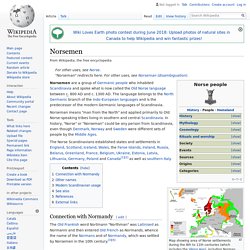
Trade and raid routes, often inseparable, are marked. Norsemen are a group of Germanic people who inhabited Scandinavia and spoke what is now called the Old Norse language between c. 800 AD and c. 1300 AD. The language belongs to the North Germanic branch of the Indo-European languages and is the predecessor of the modern Germanic languages of Scandinavia. Norseman means "man from the North" and applied primarily to Old Norse-speaking tribes living in southern and central Scandinavia.
In history, "Norse" or "Norseman" could be any person from Scandinavia, even though Denmark, Norway and Sweden were different sets of people by the Middle Ages. Connection with Normandy[edit] Other names[edit] Sami people. Traditionally, the Sami have pursued a variety of livelihoods, including coastal fishing, fur trapping, and sheep herding. Their best-known means of livelihood is semi-nomadic reindeer herding. Mari Boine - Vuoi Vuoi Mu (Vuoi Vuoi Me) Sámi Stories: Art & Identity of an Arctic People.
Sami reindeer herders battle miners to cling on to Arctic culture. When Europe’s indigenous Arctic people want to find their reindeer in a snowstorm and temperatures of -30C, they turn to their £10,000 snowmobiles and an app that is also used by British sheep farmers.

Sámi house. The Sami turf house church in Staloluokta, Sweden. Sami people win rights battle against state. Sweden’s nomadic reindeer herders have won a 30-year battle for land rights in a court case that has seen the state accused of racism towards the country’s only indigenous people.
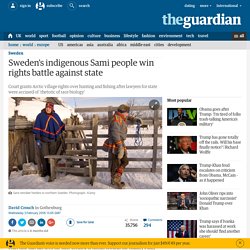
Norway's monument to 91 (Sami) murdered as witches 1593-1692. His firm paid a king-sized fine for trying to sell planes to Iran.
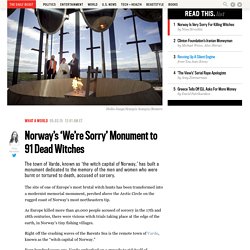
That same company was a member of the politically connected Clinton Global Initiative. An Iranian businessman accused by the U.S. government of violating sanctions on Iran donated money to the Clinton Foundation, The Daily Beast has confirmed. Vahid Alaghband’s Balli Aviation Ltd., a London-based subsidiary of the commodities trading firm Balli Group PLC, tried to sell 747 airplanes to Iran, despite a federal ban on such sales. The company pleaded guilty to two counts of criminal information in 2010. In its plea agreement with the Department of Justice, Balli Aviation agreed to pay a $2 million criminal fine, serve five years corporate probation, and pay an additional $15 million in civil fines.
Alaghband is one of an array of questionable actors who’ve been found in recent months to give to the Clinton Foundation. Reindeer herders and the fight to save a language. The gates open and the herders take us into a 300ft-wide circular pen.
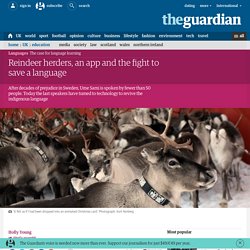
Away at the other end, 200 reindeers are running in a tightly-packed circle. Amid the silence of the forest, all you can hear is the strange, dull “clck clck” noise of the tendons in their feet. It’s December and I’m deep in the snow-covered forests in Lapland, north Sweden with a group of Sami herders – the indigenous people of this region – and their reindeers. While it feels as if I’ve been dropped into an animated Christmas card, it’s the herders not the reindeers that I’m here to meet and the conversation is not exactly festive. WIKITONGUES: Simon speaking Lule Saami. What the Sami people can teach us about adapting to climate change.
Elina Helander-Renvall comes from Utsjoki, a place so obscure that even many Finns have little idea where it is.
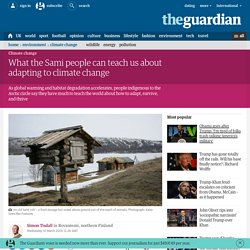
Utsjoki, or Ochejohka, Uccjuuha, and Uccjokk, depending on which local language you are speaking, is Finland's northern-most municipality. Straddling the border with Norway, it shivers, unregarded, deep inside the Arctic circle, a few icy miles from the shores of the Arctic Ocean. Utsjoki, population 1,034, is home to Finland's largest concentration of Sami speakers, the indigenous people once loosely known as Lapps who have eked out an itinerant existence herding reindeer across the frozen wastes of northern Norway, Sweden, Finland and western Russia since the last Ice Age. Nearly 50% of Utsjoki's population are Sami. In Finnish terms, it's the closest this eternal minority has got to being the majority. Born and raised on the margin though she was, Helander-Renvall's message these days is strictly mainstream.
The Arctic as a whole faces enormous challenges. Arctic ancestral survivalism: on extreme weather Sami wisdom. The Sami people (from "The Winds of the Milky Way", 1977) The wind is blowing through my heart (ENG subs, about Nils-Aslak Valkeapää) Nils-Aslak Valkeapää - Beaivi, Áhčážan (excerpt) Nils-Aslak Valkeapää - Eanan, Eallima Eadni (excerpt) Last Yoik in Saami Forests? Yoik of the Wind. What Vikings really looked like. The fine decoration of the Oseberg ship in Norway, which was buried in the year 834, provides clues to what Vikings looked like.
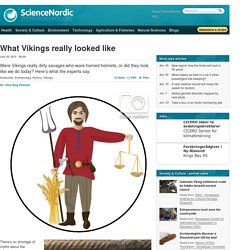
Inside the ship were two women and the archaeologists believe the ship has served as a sarcophagus. (Photo: Annie Dalbéra) There’s no shortage of myths about the appearance of our notorious Viking ancestors. To find out more about these myths, ScienceNordic’s Danish partner site, videnskab.dk, asked its Facebook readers to list their favourite myths about what the Vikings looked like. We have picked out five myths from the resulting debate and asked researchers to help us confirm or bust these myths.
Armed with this information, our graphic designer then took a shot at drawing some examples of our infamous forefathers, which you can see in our picture gallery. The five myths are: MYTH 1: Vikings were dirty and unkempt Unwashed, rough warriors with froth hanging out of the corners of the mouth. But that’s unlikely to be true: It wasn’t enough just to be clean.